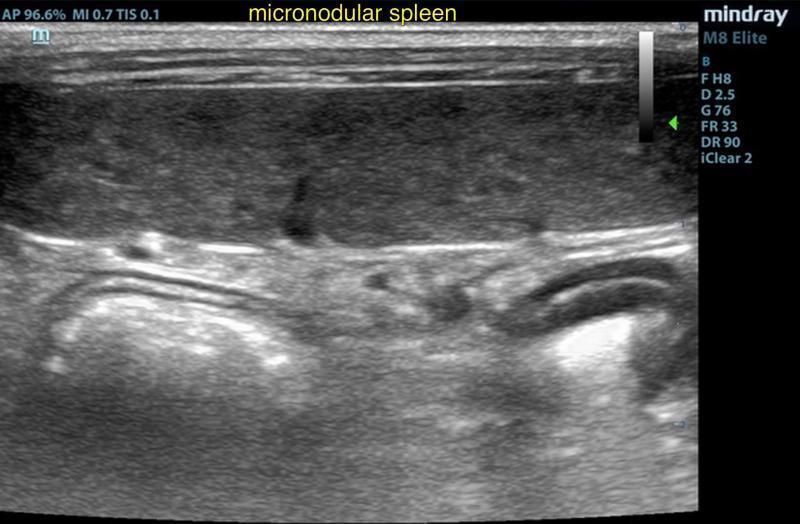Here is a great example of how the linear probe in certain animals and situations can further define your imaging and potential pathology. The first image is a feline spleen imaged with the C11, the second is the same spleen with the L14. This spleen is mildly enlarged with uniform, but subtly micronodular parenchyma, and undulating capsular contour.
The linear probe really brings out the micronodular changes. Consistent with splenitis, reactive spleen due to immune stimulus, or early round cell neoplasia.
Here is a great example of how the linear probe in certain animals and situations can further define your imaging and potential pathology. The first image is a feline spleen imaged with the C11, the second is the same spleen with the L14. This spleen is mildly enlarged with uniform, but subtly micronodular parenchyma, and undulating capsular contour.
The linear probe really brings out the micronodular changes. Consistent with splenitis, reactive spleen due to immune stimulus, or early round cell neoplasia.
The linear works best for depths < 5 cm – use it on every cat abdominal; you will pick up adrenals, see smaller reactive lymph nodes clearly and it will make a D-pap pop. Great for all bladder/urethral/prostate pathology in dogs and cats. Try it on dog adrenals also when you can image them at 2-3 cm and see if you can bring in the cortex and medulla.
Note on the linear image here- the focal point is placed perfectly right on the organ of interest. The Elite 8 is very focal point sensitive and its placement will make a difference in your imaging.


Comments
Ahhhhh, so beautiful! 🙂
I
Ahhhhh, so beautiful! 🙂
I LOVE the linear probe! Pretty images. Unfortunately I don’t find it much use on really big dogs with the <5cm thing…. but I haven’t tried it specifically on urethra/prostate. I’ll try that on my next big dog….
Karen
OMG for urethra and prostate
OMG for urethra and prostate the Linear is a dream! Also for cats or smaller dogs that have adrenal glands with less gusto it can really light them up. 🙂
Hi, I am an european and a
Hi, I am an european and a proud mindray M9 user. It seems to me that this is the same machine (at least the case is) as the Elite 8.
To the users that don’t have access to the linear probe it would be useful to turn on the harmonics, particularly in small pacients or superficial tissues. It really improves your image. Of course, it is no linear, but sometimes it can make a difference!
Yes the Elite 8 and M9 are
Yes the Elite 8 and M9 are similar; the M9 and M7 were the foundation for the upgraded Elite 8. The Elite 8 has a faster processor and better imaging right out of the box . We have found that the software version definitely matters (as is true with all ultrasound machines) as far as quality of imaging.
After a lot of trials in the field with the Elite 8, we found the best version for veterinary imaging, and we make sure this version is installed on all of the Elite 8 units we sell.
Thanks for the tip!
My understanding is that the harmonics function is always enabled, and you use the frequency switch (image quality) on the soft menu- 1st switch on the left under the screen to adjust through the levels of fundamental frequency and harmonic frequency
I will post some additional information regarding frequency and harmonics tomorrow:)